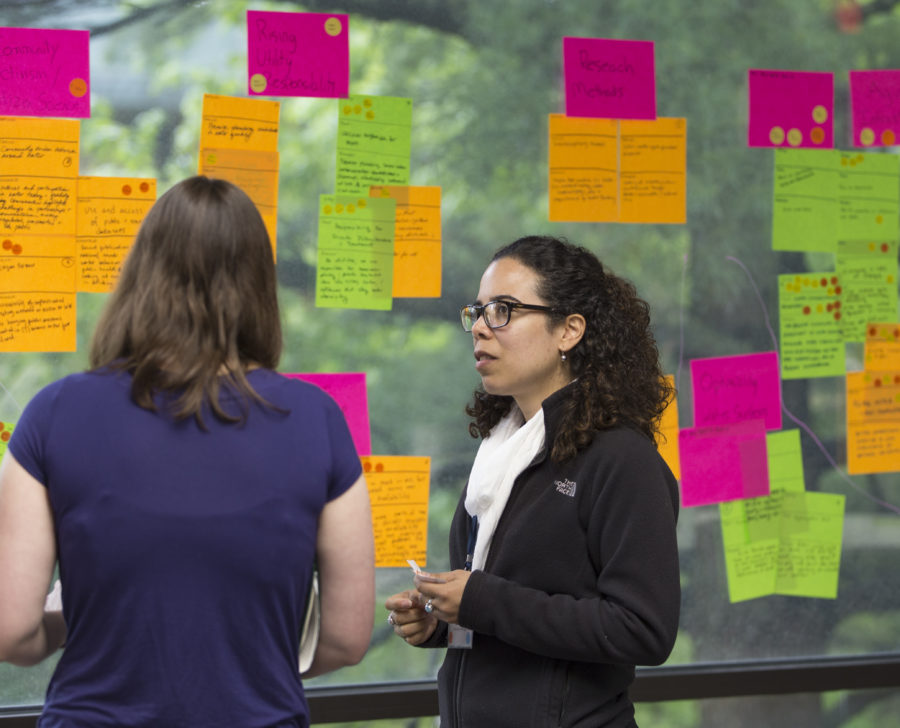Innovation Salon
By December of 2018, Dr. Lut Raskin, Professor of Environmental Engineering at the University of Michigan, had spent much of her career in partnership with water utility leaders. Likewise, Water Treatment Manager for the City of Ann Arbor and long-time collaborator of Dr. Raskin’s, Brian Steglitz had received many requests from researchers throughout his career that did not reflect the same collaborative spirit as his working relationships with Dr. Raskin.
Story by Malin Andersson
Based on their experiences, Raskin and Steglitz saw a need to bring researchers and water utility managers together to develop a shared appreciation for the challenges, goals, and specific needs of each community. By fostering a meaningful understanding between researchers and managers, Raskin and Steglitz hoped to uncover details of the shared needs for innovation surrounding drinking water. Additionally, the pair wished to connect solution providers and innovators (i.e., research community) with the practicians and problem owners (i.e., utilities). They believed by bringing these two communities together, the team could both introduce the challenges that utilities were facing to the research community and see if they could develop new partnerships for developing innovative solutions.
For this event to run smoothly and encourage participants to collaborate in innovative ways, intentional facilitation would be essential. That’s where The Center for Socially Engaged Design (C-SED) comes in.
Dr. Raskin reached out to C-SED Strategic Director Ann Verhey-Henke for support in creating the event that would become the “Drinking Water Innovation Salon.” Building on previous work, Ann Verhey-Henke recognized an exciting opportunity to support Raskin and Steglitz realize their vision for more collaborative engagement across sectors that could lay the groundwork for positive and sustainable change moving forward.
If the term “Innovation Salon” is new to you, Blue Sky defines the practice as a facilitated gathering of people with diverse backgrounds and expertise who have in-depth discussions about innovation in a particular area of interest. Through the Drinking Water Innovation Salon, Raskin and Steglitz sought to highlight different points of view, providing the space for each stakeholder to express their goals as well as metrics of success.

Ann Verhey-Henke on the day of the Innovation Salon
At the heart of the Center for Socially Engaged Design (C-SED), you will find a dedication to meaningful collaboration. C-SED believes that intentional, inclusive, and supportive gatherings for stakeholders are essential for positive change to occur. Facilitation is an important aspect of this process and C-SED is always looking for opportunities to support faculty members and students alike in their search for equitable and sustainable solutions.
The Michigan Drinking Water Innovation Salon in May 2019 continues to represent the positive impact of collaboration – both in its creation and facilitation.
Iterating Together
Raskin and Steglitz began to meet weekly with Verhey-Henke and C-SED graduate facilitator Suzanne Chou. During these meetings, Verhey-Henke and Chou asked questions and proposed ideas in order to understand Raskin and Steglitz’s goals and support their vision.
“It was always iterative. Iteration was everywhere,” says Verhey-Henke. “Suzanne and I were prototyping left and right. We took their goals, came up with some ideas, and then we would bring it back the next week when Lut and Brian would then pick it apart and give really thoughtful feedback.” Raskin, Steglitz, Verhey-Henke, and Chou began to map out the day, motivated by the lack of a shared perspective between academic water researchers and water utility managers. Through a mix of both listening and sharing at the Innovation Salon, the planning team wanted participants to identify intersections between researchers and utility managers, creating a stronger network.

Early map of the day
Planning for Intentional Facilitation
Throughout their four months of meetings with Raskin and Steglitz, Verhey-Henke and Chou crafted a single objective: To build a better understanding, and therefore a better connection, between academic water researchers and the people on the ground who are actively doing water utility work.
From thinking about the colors of Post-It notes to intentional seating, thoughtful facilitation helped the Innovation Salon reach its full potential. “The planning and intentionality behind facilitation is really powerful in that you make sure that the participants feel as supported and heard as much as we can make it, but also make it fun because of the creative piece of it.” (Chou)
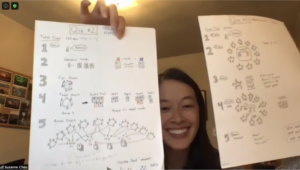
Suzanne Chou holds up the early-stage visualization of the day
With endless possibilities, Raskin, Steglitz, Chou, and Verhey-Henke thought deliberately about every step, including those who would be in the room together.
Not only would three different research institutions be represented at the Innovation Salon (University of Michigan, Wayne State University, and Michigan State University) but water utilities ranging in size would also be represented. With this diversity, the planning team felt confident that a plethora of experiences would be shared.
Towards the end of the planning process, a facilitation guide was created to support and guide facilitators. The goals of the event are listed clearly:
The City of Ann Arbor and the University of Michigan seek to create a workshop space to engage a diverse group of drinking water utility companies and researchers with the most pressing issues facing Michigan’s drinking water. The goals of this Innovation Salon are to allow for:
-
-
-
-
- Open dialogue between researchers and water utility companies across Michigan
- Shared understanding of various key stakeholder perspectives and needs
- Identification of overlapping avenues for collaboration between researchers and water utility representatives
- Brainstorm potential paths forward to develop innovative solutions to address key challenges faced by the drinking water industry in Michigan
-
-
-
With this facilitation guide in place, finally, the day could happen.
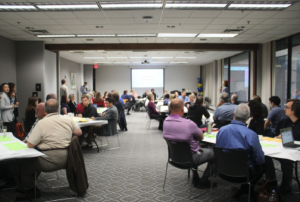
Participants gather in Pierpont Commons on May 22, 2019
Actualizing the Design
The entire Innovation Salon was crafted around the desire for each participant to find and express their own voice. Making a comfortable yet energetic space was essential for each participant to leave the event feeling heard and supported.
As convener and facilitator, C-SED aims to create “yes, and…” opportunities for collaborative work so that everyone feels free to do their best thinking and contribute. Our methods are designed to make all participants feel heard and respected so that they gain a sense of ownership of the end result. By taking on the role of facilitator, designers at C-SED allow the leaders of initiatives to act as fellow participants during workshop activities. We deliberately set up time and space for leaders to do the conversational, shoulder-to-shoulder work that is so vital in establishing a team and a vision.
Through the facilitation of Verhey-Henke and Chou, Raskin and Steglitz were able to experience the day as participants as well as planners.
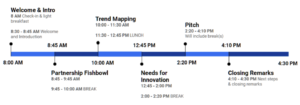
The Official Itinerary
Partnership Fishbowl: Highlighting and Building Connection – 8:45am
Lut Raskin and Brian Steglitz’s partnership, built on mutual respect for their shared and individual interests, is a great example of what can happen when researchers and utility managers work together. They wanted the Partnership Fishbowl to showcase other researchers and water utilities who were building reciprocal relationships.
The goal of the Partnership Fishbowl was to create positive energy around the possibility of collaboration, identify the aspects of a beneficial partnership, and begin building empathy for the challenges of both water utilities and researchers.
In order to achieve this goal, C-SED Facilitator Ann Verhey-Henke interviewed City of Adrian Water Superintendent Tim Ritchie and Michigan State professor Dr. Joan Rose about how they work together, what they appreciate from the collaboration, and how they work together towards both their shared and individual goals.
Then, participants broke out into small groups to reflect on the key characteristics of positive collaboration. They began generating a future vision for what utilities and researchers want, seeing patterns of shared collaboration desires emerge.
Because of this activity, momentum was built, leading to a growing excitement towards learning more from each other as the day progressed. Participants began to develop a shared appreciation for each group’s challenges and needs.
The pursuit of finding commonalities energized the room, planning the seeds for productive conversations that would only grow as the day progressed.
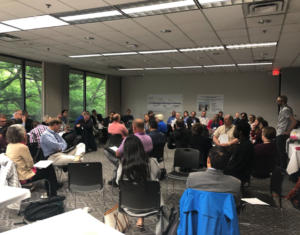
Participants gather for the partnership fishbowl
Trend Mapping: Cultivating Awareness and Understanding – 10:00am
After the Partnership Fishbowl, participants were prompted with the question: What are three key trends you see the drinking water industry facing in the next five to ten years? This exercise was an opportunity for participants to share ideas through writing and small group discussions.
The goal of Trend Mapping was to understand the broad trends within the drinking water industry and discover the trends that overlap (or don’t) between industry and research.
In order to achieve this goal, participants started as individuals to think about the areas they pay attention to within the drinking water industry. Then, they wrote their ideas down on sticky notes (utility participants on green sticky notes and researcher participants on orange sticky notes) and shared them with a partner from the same role.
Next, trends were shared within small groups of different roles. Facilitators encouraged conversations within the mixed groups before inviting them to vote for which issues mattered most to them. The colors and sizes of sticky dots indicated the group from which the person was voting and the significance of the trend for them.
Because of this activity, collective areas of interest were identified and participants began to think about where they would like to see collaboration and innovation. Researchers and utility representatives learned about how their research and/or work within water utility could lead to an interesting partnership in that space, area of need, or question.
With the sun illuminating the sticky notes through the windows, the rainbow of colors representing the richness of experience and perspectives in a single room, Raskin and Steglitz finally got to see their vision take shape.
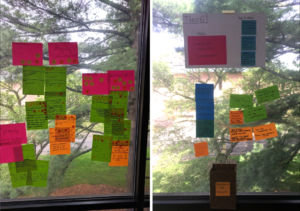
Sticky notes with goals were placed on the window for all to read
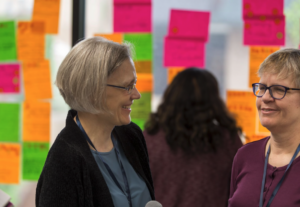
Dr. Raskin speaks with Professor Terri Olson, Professor of Civil and Environmental Engineering
Needs for Innovation: Identifying Alignment – 12:45pm
After providing the space for trend mapping, the facilitators gathered the participants into groups based on interest in working on a specific trend to brainstorm needs for innovation.
The goal of the Needs for Innovation was to identify the areas in each individual’s work and trend space that are in need of innovation.
In order to achieve this goal, participants brainstormed 5-10 needs as individuals for innovation within their area. Then, they shared their thoughts as a table. Next, they worked together to decide the top three needs for innovation for both utilities and universities.
Once they had identified the top three needs for innovation, each group began ideating innovation projects that would address each need. This ideation would then be turned into a pitch. Because of this activity, needs for innovation were identified, empathy continued to grow for both utility workers and researchers, and the beginning of an action plan in the form of innovation projects began to take form.
Thoughtful chatter ran through the room, bringing exciting ideas and hopes with it. These solutions were shared in front of the entire group, creating a sense of community to last well past the event itself.
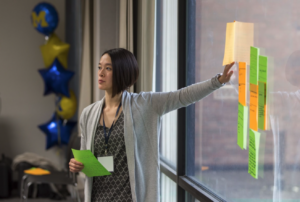
Suzanne Chou shares the priorities of both researchers and water utilities
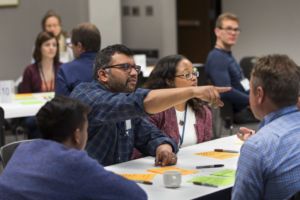
Participants vocalize their experiences
The Pitch: Discovering Opportunity – 2:20pm
The day culminated in pitches. The energy that emerged in the Partnership Fishbowl had turned into the excitement of innovation and collaboration.
The goal of the Pitches was to share the ideas for innovation each group came up with while bringing awareness of needs, building excitement for future collaboration, and planting seeds for future innovation.
In order to achieve this goal, each group presented the pitch they created to the entire room with the aim to convince other participants to collaborate on their project.
Because of this activity, potential plans for future innovation were offered up to all participants for the opportunity to pursue later down the line. The effort of building empathy and identifying trends throughout the day culminated in the seeds for future partnerships.
At the end of an 8-hour day, Raskin, Steglitz, Chou, Verhey-Henke, and the many others who had joined the Innovation Salon team took in a deep breath. They passed out contact information for participants and thanked everyone as they left the room.
Still surrounded by colorful sticky notes, they celebrated their work, recorded all of the information shared, and prepared for their next steps.

Professor Eric Schwartz pitches needs for innovation to the rest of the participants
Moving Forward
Since the Drinking Water Innovation Salon, Ann Verhey-Henke has looked back on the planning and facilitation process as the ideal situation in which designers thrive – closely working with faculty members and students to help them realize their vision.
“I still point to our work with Innovation Salon as an ideal collaboration in the way we as designers and facilitators of events love to work.” (Verhey-Henke)
The work of the Innovation Salon went beyond the single event, branching off into new opportunities.
“Through conversations with Lut and Brian, we started to explore the potential for a team of people to help them understand the broader stakeholder groups,” says Verhey-Henke.
Following the Innovation Salon, Verhey-Henke led a grant sprint, or an accelerated and focused effort to plan, create, and write a grant proposal. Additionally, Dr. Raskin and the Blue Sky Initiative helped fund a 12-week Summer Studio project comprising two teams of nine student interns. This “deep dive” resulted in a presentation by students at the Michigan Section of the American Water Works Association annual meeting later that fall. The presentation expanded upon the issues explored during the Innovation Salon, creating connections that still expand from the original single-day event.
Dr. Lut Raskin summarized her experience working with C-SED to create the Innovation Salon, stating, “C-SED has demonstrated the ability to deliver high-quality experiential learning opportunities for students and exceptional faculty support — often achieving both simultaneously through unique workshops, grant sprints, and summer studio opportunities that bring faculty, students, and external partners together to advance the university’s mission of innovative education, scholarship, and outreach.”
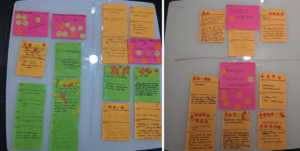
The colorful sticky notes that came to represent diversity, commonality, and ultimately, collaboration
Realizing Your Own Vision
C-SED is always looking for the next opportunity to help faculty, external groups, or students realize their visions. If you would be interested in collaborating with C-SED to facilitate or design an event or workshop, you can reach Ann Verhey-Henke here.



